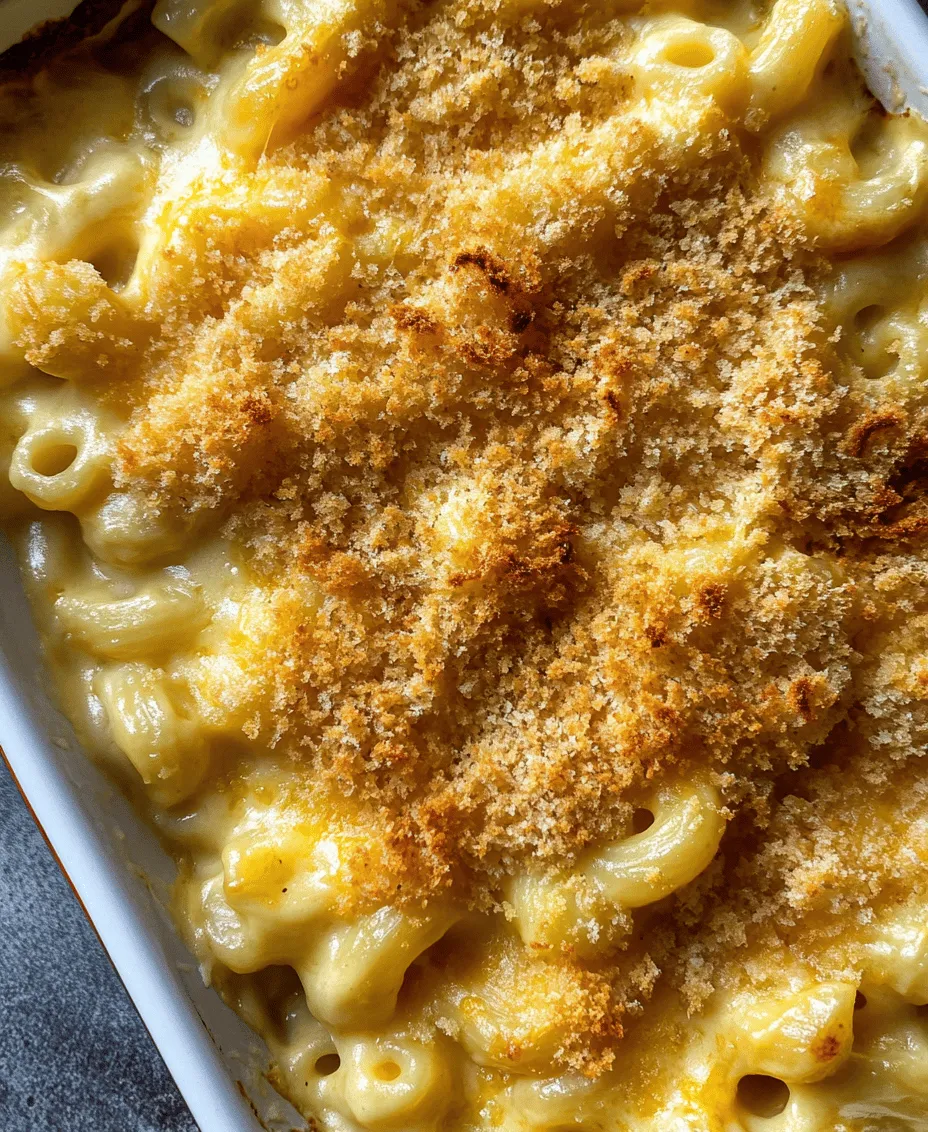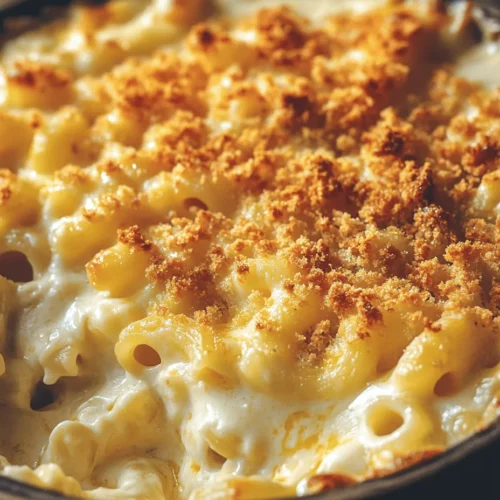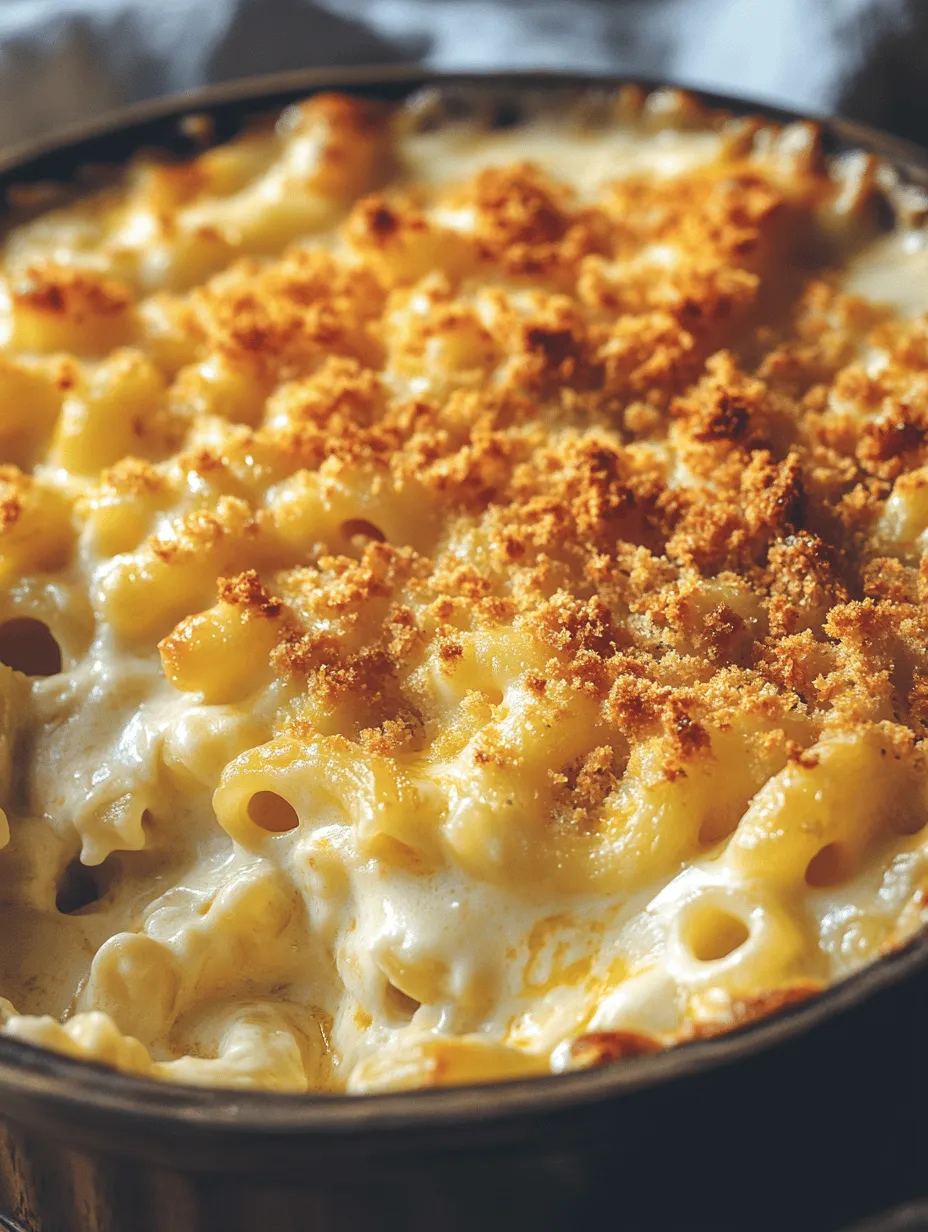Introduction to Mac and Cheese: The Ultimate Comfort Food
Mac and cheese is more than just a dish; it’s a culinary institution that has captured the hearts and taste buds of people around the world. This creamy, cheesy delight is often associated with nostalgia—reminding many of family gatherings, cozy evenings at home, and the simple joy of a warm meal. Whether served as a side dish or a main course, mac and cheese stands out as the ultimate comfort food, offering a perfect balance of flavors and textures that satisfies the soul.
The origins of mac and cheese can be traced back to Europe, with roots in Italy and the United Kingdom. The earliest known recipe dates back to the 18th century in a cookbook published in England, which featured a dish of pasta and cheese baked together. Over the centuries, this dish evolved, crossing the Atlantic to the United States, where it became a staple in American cuisine. The post-war era saw a surge in popularity with the introduction of boxed mac and cheese, making it an easy and affordable meal for families. However, as culinary trends have shifted towards homemade meals, the appreciation for traditional, scratch-made mac and cheese has surged, emphasizing the importance of fresh ingredients and personal touches.
Homemade mac and cheese offers a level of flavor and creaminess that store-bought versions simply cannot match. When you prepare it from scratch, you have complete control over the ingredients, allowing for customization according to personal tastes and dietary needs. This versatility is one of the reasons mac and cheese remains a beloved dish today. Whether you prefer it baked with a crunchy topping, stovetop for a quick meal, or loaded with additional ingredients like bacon, vegetables, or gourmet cheeses, the possibilities are endless.
In this article, we will explore the essential ingredients that make up this classic comfort food, followed by a detailed step-by-step guide to creating your very own homemade mac and cheese.
Understanding the Ingredients of Mac and Cheese
To create the ultimate mac and cheese, it is essential to start with high-quality ingredients that contribute to the dish’s rich flavor and creamy texture. Let’s dive into the key components that will elevate your mac and cheese from basic to extraordinary.
Elbow Macaroni: The Classic Choice
When it comes to pasta, elbow macaroni is the traditional choice for mac and cheese. Its small, curved shape allows it to hold onto the cheese sauce beautifully, ensuring that every bite is packed with flavor. While elbow macaroni is a classic, feel free to experiment with other pasta shapes, such as shells or cavatappi, which can also enhance the texture and presentation of your dish.
Unsalted Butter: Importance in Flavor and Texture
Butter is a fundamental ingredient in mac and cheese, providing richness and depth of flavor. Unsalted butter is preferred, as it allows you to control the salt content of your dish. The butter serves as the base for the roux, a mixture of fat and flour that thickens the cheese sauce. Using high-quality butter can significantly impact the overall taste of your mac and cheese, so opt for a good brand whenever possible.
All-Purpose Flour: Role in Thickening the Sauce
All-purpose flour plays a crucial role in the mac and cheese recipe by helping to create a smooth, creamy sauce. When combined with butter to form a roux, it thickens the milk and cheese mixture, resulting in a luscious sauce that clings to the pasta. It’s important to cook the roux long enough to eliminate the raw flour taste without browning it, as this will affect the color and flavor of your final dish.
Milk: Choosing Between Whole and 2% for Creaminess
Milk is another essential ingredient that contributes to the sauce’s creaminess. For the best results, whole milk is recommended, as it adds richness and body to the cheese sauce. However, if you prefer a lighter version, you can use 2% milk, though the sauce may not be as indulgent. Some recipes even call for heavy cream or a combination of milk and cream for an ultra-creamy texture, but this is entirely up to your preference and dietary considerations.
Cheddar and Mozzarella: The Perfect Cheese Blend
No mac and cheese is complete without cheese, and the combination of cheddar and mozzarella is a match made in heaven. Cheddar cheese brings a sharp, tangy flavor that is characteristic of classic mac and cheese, while mozzarella adds creaminess and stretchiness to the sauce. For an even richer flavor profile, consider adding other cheeses such as Gruyère, fontina, or even blue cheese for a gourmet twist. Always opt for block cheese when possible, as pre-shredded cheese often contains anti-caking agents that can affect the sauce’s texture.
Optional Ingredients for Customization
While the classic mac and cheese recipe is delicious on its own, there are plenty of optional ingredients you can add to elevate your dish. Here are some ideas for customization:
– Garlic and Onion Powder for Flavor Enhancement: Adding a pinch of garlic powder and onion powder to the cheese sauce can enhance the flavor profile without overpowering the dish. Fresh garlic and sautéed onions also work beautifully if you prefer fresh ingredients.
– Breadcrumbs for a Crunchy Topping: For those who enjoy a crunchy topping, a mixture of breadcrumbs and melted butter can be sprinkled over the mac and cheese before baking. This adds a delightful contrast to the creamy pasta and gives your dish a beautiful golden color.
Discussion on Ingredient Quality and Sourcing
When it comes to making mac and cheese, the quality of your ingredients can make a significant difference. Choose fresh, high-quality cheeses from local dairies when possible, as they will impart better flavor compared to mass-produced options. Additionally, consider sourcing organic pasta and dairy products to ensure you’re using wholesome ingredients. Shopping at farmer’s markets or specialty grocery stores can often lead to discovering unique cheeses and artisanal products that can enhance your mac and cheese experience.
Step-by-Step Guide to Making Mac and Cheese
Now that we’ve covered the essential ingredients, let’s dive into the step-by-step process of making the perfect mac and cheese. The following instructions will guide you through preparing the pasta and crafting a creamy cheese sauce that will leave your taste buds wanting more.
Preparing the Pasta
The first step in creating your homemade mac and cheese is to prepare the pasta. The type of pasta you choose is crucial, and elbow macaroni is the traditional option that works best.
1. Bring a Pot of Water to a Boil: Fill a large pot with water and add a generous amount of salt (about 1 to 2 tablespoons). The salt will enhance the flavor of the pasta as it cooks.
2. Cook the Macaroni Al Dente: Once the water is boiling, add the elbow macaroni and cook according to the package instructions, typically around 7-8 minutes. It’s essential to cook the pasta al dente—firm to the bite—since it will continue to cook when combined with the cheese sauce and baked, if desired.
3. Drain and Rinse: After the pasta is cooked, drain it in a colander and rinse it briefly under cold water. This helps stop the cooking process and removes excess starch that could cause the pasta to stick together.
Crafting the Cheese Sauce
While the pasta is cooking, you can begin crafting the cheese sauce, which is the heart of any mac and cheese recipe. Follow these steps for a smooth, lump-free sauce:
1. Make the Roux: In a separate large saucepan, melt 4 tablespoons of unsalted butter over medium heat. Once melted, add 4 tablespoons of all-purpose flour, stirring continuously for about 1-2 minutes. This cooking process helps eliminate the raw flour taste and forms the foundation for your cheese sauce.
2. Add the Milk: Gradually whisk in 2 cups of milk (whole or 2%) to the roux, ensuring there are no lumps. Continue to whisk until the mixture is smooth and begins to thicken, typically around 5-7 minutes.
3. Incorporate the Cheeses: Once the sauce has thickened, remove it from heat and stir in 2 cups of shredded cheddar cheese and 1 cup of shredded mozzarella cheese. Mix until the cheeses are fully melted and incorporated into the sauce. If you desire a more intense flavor, feel free to add additional cheeses at this stage.
With the pasta cooked and the cheese sauce ready, you now have the components to assemble your mac and cheese masterpiece. This step-by-step guide sets the foundation for a delicious, homemade dish that will surely impress friends and family alike.
In the next section of this article, we will continue with the final assembly of your mac and cheese, along with tips for baking and serving. Stay tuned for a complete and satisfying mac and cheese experience!

How to Achieve the Perfect Melt for a Creamy Sauce
To create an irresistibly creamy mac and cheese, mastering the cheese melt is essential. Start with high-quality cheeses that melt beautifully, such as cheddar, Gruyère, or Monterey Jack. The key is to grate your cheese rather than using pre-shredded varieties. Pre-shredded cheese contains anti-caking agents that can hinder the melting process, leading to a grainy sauce.
When you’re ready to incorporate your cheese into the sauce, do so off the heat. This prevents the cheese from getting too hot and separating. Gradually stir in the cheese, allowing it to melt slowly and uniformly. For an extra creamy consistency, consider adding a splash of heavy cream or milk to the cheese sauce just before incorporating the cheese. This will help achieve that velvety texture that everyone loves in mac and cheese.
Balancing Flavors with Seasonings
To elevate your mac and cheese, balancing flavors with seasonings is crucial. Start with the basics: salt and pepper. Salt enhances the natural flavors of the ingredients, while black pepper adds a subtle kick. Don’t shy away from experimenting with garlic powder, onion powder, or paprika for added depth. A pinch of nutmeg can also give the dish a warm, aromatic undertone.
For a touch of heat, consider incorporating a dash of cayenne pepper or crushed red pepper flakes. If you’re looking to add a tangy flavor, a tablespoon of Dijon mustard works wonders, giving your mac and cheese a sophisticated twist. Always taste your sauce as you add seasonings to ensure the flavors are well-balanced and tailored to your preferences.
Combining Pasta and Sauce
Once your cheese sauce is perfectly melted and seasoned, it’s time to combine it with the pasta. Begin by cooking your macaroni according to package directions until al dente — slightly firm to the bite. This prevents the pasta from becoming mushy after baking or mixing with the sauce. Drain the pasta but reserve a cup of the pasta water; this starchy liquid can help adjust the sauce’s consistency if needed.
In a large mixing bowl or pot, combine the drained pasta and cheese sauce, stirring gently to coat every piece of macaroni. If the sauce seems too thick, gradually add some reserved pasta water until you achieve your desired creaminess. This step is crucial for ensuring that each macaroni is enveloped in that luscious cheese sauce.
Tips for Ensuring Even Coating of Macaroni
Achieving an even coating on your macaroni is vital for a consistent flavor and texture. To ensure that every piece of pasta is well-coated, follow these tips:
1. Toss Gently: Use a large spoon or spatula to fold the pasta into the sauce, rather than stirring vigorously, which can break the pasta.
2. Use Hot Sauce: Combine the macaroni with the cheese sauce while both are still hot. This helps the sauce cling better to the pasta.
3. Layering Technique: If you’re baking the mac and cheese, consider layering some sauce and pasta before adding more, then finish with a final layer of sauce on top. This technique ensures that the flavors are well-distributed throughout.
Optional Baking for a Crispy Topping
One of the best ways to elevate mac and cheese is by baking it with a crispy topping. This adds a delightful texture contrast to the creamy interior. For a classic crispy topping, combine breadcrumbs with a bit of melted butter and sprinkle them evenly over the mac and cheese before baking. You can also mix in some grated cheese for extra flavor.
Benefits of Baking Mac and Cheese
Baking mac and cheese not only enhances its flavor but also gives it a delightful golden crust. The baking process allows the flavors to meld together beautifully, creating a richer taste. The high heat caramelizes the top layer, resulting in a deliciously crispy texture that contrasts with the creamy sauce beneath.
Ideal Baking Temperatures and Times for the Best Texture
To achieve the perfect baked mac and cheese, preheat your oven to 350°F (175°C). Transfer your mac and cheese into a greased baking dish and bake for about 20-25 minutes, or until the top is golden brown and bubbly. You can broil it for an additional 2-3 minutes at the end for an extra crispy topping, but keep a close eye on it to prevent burning.
Exploring Variations and Customizations of Mac and Cheese
One of the most exciting aspects of mac and cheese is its versatility. You can easily customize the recipe to suit your taste preferences or dietary needs.
Different Types of Cheeses to Experiment With
While cheddar is a classic choice, consider mixing different cheeses for a more complex flavor profile. Gouda adds a smokiness, while fontina brings creaminess. For a tangier bite, try incorporating blue cheese or goat cheese. Mixing cheeses can transform your mac and cheese into a gourmet dish that impresses family and friends.
Adding Proteins: Bacon, Chicken, or Vegetables
For those looking to add protein, bacon or pancetta adds a delightful crunch and salty flavor. You can also mix in cooked chicken or turkey for a heartier meal. If you prefer a vegetarian option, adding sautéed vegetables like broccoli, spinach, or roasted red peppers not only boosts nutrition but also adds vibrant color and flavor.
Global Twists: Incorporating Spices and Flavors from Different Cuisines
Get creative by incorporating flavors from various cuisines. For instance, adding a hint of curry powder can give your mac and cheese an Indian twist, while incorporating chipotle peppers in adobo sauce lends a smoky, spicy flavor reminiscent of Mexican cuisine. Experimenting with herbs, spices, and sauces is a fun way to make the dish uniquely yours.
Vegan and Gluten-Free Alternatives
For those following a vegan or gluten-free diet, there are plenty of alternatives. Use gluten-free pasta made from rice, quinoa, or chickpeas, and create a cheese sauce with cashews, nutritional yeast, and coconut milk for a creamy, dairy-free option. There are also many store-bought vegan cheese options available that melt well, providing a satisfying alternative.
Serving Suggestions for Mac and Cheese
Once your mac and cheese is ready, consider how to serve it for maximum enjoyment.
Ideal Pairings: Sides and Beverages That Complement the Dish
Mac and cheese pairs wonderfully with a variety of sides. A fresh green salad with a light vinaigrette can balance the richness of the dish. Roasted vegetables or garlic bread also make excellent accompaniments. For beverages, consider pairing your mac and cheese with a crisp white wine, like Chardonnay, or a light beer, such as a pilsner.
Presentation Tips for a Visually Appealing Dish
To make your mac and cheese visually appealing, serve it in a beautiful dish that highlights its creamy texture and golden topping. Garnish with freshly chopped parsley or chives for a pop of color. If you’ve added toppings like bacon or breadcrumbs, allow them to peek out from the cheese for an inviting presentation.
Family-Style Serving Versus Individual Portions
Decide whether you want to serve your mac and cheese family-style in a large dish or in individual portions. Family-style serving creates a warm, communal atmosphere, while individual portions can add a touch of elegance to your meal. If serving individually, consider using ramekins for a charming presentation.
Nutritional Aspects of Mac and Cheese
While mac and cheese is a comfort food favorite, it’s important to consider its nutritional value.
Breakdown of Calories and Nutrients Per Serving
A typical serving of mac and cheese can range from 300 to 600 calories, depending on the ingredients used. It’s usually high in carbohydrates and fats, with moderate protein content from the cheese and pasta. Keep in mind that adding proteins or vegetables can adjust these numbers.
Discussing Balance in a Comfort Food Diet
Incorporating mac and cheese into a balanced diet is all about moderation. Enjoy it as an occasional treat rather than a daily staple. Pair it with nutritious sides to create a well-rounded meal, ensuring you’re getting a variety of nutrients.
Suggestions for Making Mac and Cheese a Healthier Choice
To make mac and cheese healthier, consider using whole-grain pasta for added fiber, reducing the amount of cheese, or substituting some of the cheese with pureed vegetables like cauliflower or butternut squash for a creamy texture. You can also add legumes or lean proteins to boost the nutritional profile.
Conclusion: Embracing the Comfort of Homemade Mac and Cheese
Homemade mac and cheese is more than just a meal; it’s a comforting dish that evokes feelings of nostalgia and warmth. The joy of creating this classic recipe in your kitchen allows you to customize it to your taste, making it a truly personal experience. Embrace the tradition of mac and cheese, and consider it a canvas for your culinary creativity.
Family traditions surrounding food often bring people closer together, and sharing a homemade dish like mac and cheese can create lasting memories. Whether you stick to the classic recipe or explore new variations, the important thing is to enjoy the process. So gather your loved ones, experiment in the kitchen, and unleash the ultimate comfort food that is mac and cheese!


